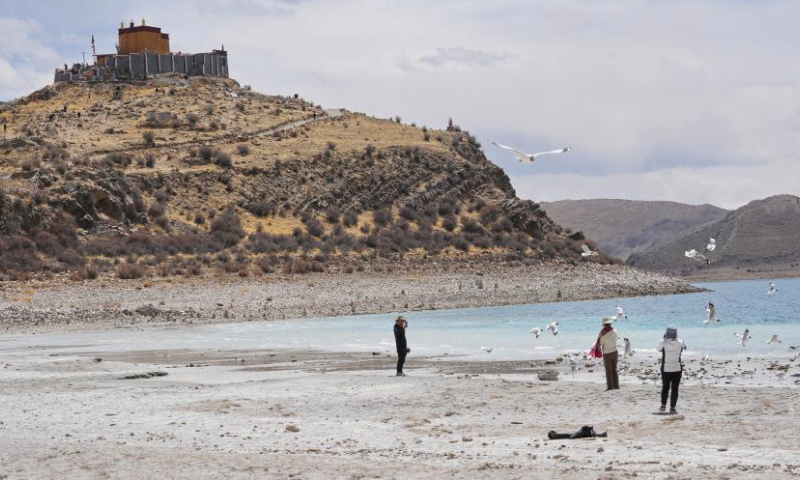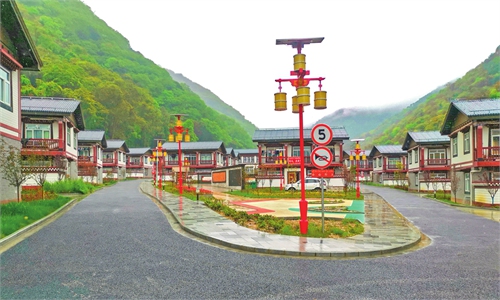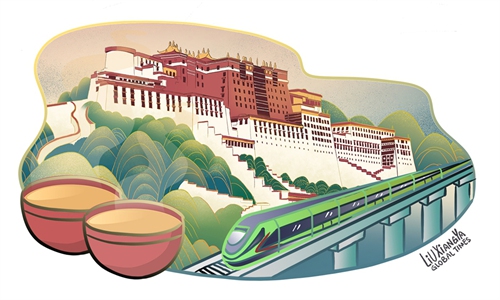Xizang to improve efficiency of processing documents for foreign visitors amid opening-up and development since peaceful liberation

Tourists feed brown-headed gulls by the Yamzbog Yumco Lake in southwest China's Xizang Autonomous Region, April 5, 2024. (Xinhua/Zhang Rufeng)
Officials from Southwest China's Xizang Autonomous Region on Thursday, the 73rd anniversary of the Xizang peaceful liberation, said the region will work on enhancing the range of tourist offerings and improving the efficiency of processing documents for foreign visitors entering the region.
In 2023, the number of trips paid to the autonomous region reached 55.17 million from home and abroad, and the tourism revenue reached 65.1 billion yuan ($9 billion), up 83.7 percent and 60 percent respectively compared with the previous year, both reaching record highs. Nearly 20,000 foreign tourists visited Xizang in 2023 and the number of foreign visitors reached 4,300 in the first quarter of this year, Yan Jinhai, chairman of the government of Xizang, told Thursday's press conference.
Xu Zhitao, vice chairman of Xizang government, also said at the event that the region aims to enhance the range of tourist offerings and improve the efficiency of processing documents for foreign visitors entering Xizang. It is hoped that initiatives focusing on language translation and e-payment systems will further enhance the appeal of Xizang to international tourists.
Meanwhile, Xu revealed that Xizang plans to open more direct flights to mainland cities and international markets, which will attract more investment enterprises to enter the local cultural tourism market.
Officials welcomed more international visitors to visit Xizang and experience its diverse landscapes, magnificent palaces, beautiful temples and unique architectural styles of residential buildings. "All of these will surely bring unexpected surprises to our travelers during their journey," Xu said.
Over the past 73 years, under the strong leadership of the Communist Party of China (CPC), the region has strived to forge a new path for high-quality economic development, with people from different ethnic minorities living happily together. Tourism resources continue to attract visitors from both home and abroad, officials said at the press conference.
On May 23, 1951, the Agreement of the Central People's Government and the Local Government of Tibet on Measures for the Peaceful Liberation of Tibet (the 17-Article Agreement) was signed. The people of Xizang broke free from the fetters of invading imperialism, embarking on a bright road of unity, progress and development with all the other ethnic groups in China.
Since the peaceful liberation of Xizang, the region has developed alongside the motherland in the process of reform and opening-up. Tremendous changes have taken place in various aspects such as politics, economy, culture, society, environment, infrastructure, communications and information technology, Xiong Kunxin, a professor at Minzu University of China in Beijing, told the Global Times on Thursday.
It is no exaggeration to say that this is a monumental change in Xizang's history, leading to leapfrog development, Xiong said. "Now, the various ethnic groups of Xizang residents are living in a favorable atmosphere of political stability, ethnic unity, religious harmony with improving living conditions. All of this is closely related to the agreement signed 73 years ago."
Since the start of the 14th Five-Year Plan (2021-2025), the total GDP of the Xizang region has increased from 190 billion yuan to 240 billion yuan last year, with per capita GDP rising from 52,300 yuan to 60,000 yuan. The growth rate of per capita disposable income for urban and rural residents has remained at the forefront nationwide for many years, Yan noted.
The scene in Barkhor Street in Lhasa has vividly depicted the ethnic unity of Xizang. With a long history of more than 1,300 years, Barkhor Street is home to more than 20 ethnic groups such as Tibetans, Han, Hui and Monba living, studying and working together and enjoying life together in more than 100 residential compounds, just like one big happy family, Yan said.
At the Thursday's conference, Yan also mentioned the advantage of Xizang in the country's high-quality development landscape. He said that Lhasa, the capital city of Xizang, is known as the "city of sunshine" where the annual sunshine time is 3,500 hours.
Xizang has a potential solar energy development capacity of 9.8 billion kilowatts, 1.7 billion kilowatts of hydropower resources, and 1.8 billion kilowatts of wind energy, excluding geothermal and pumped storage energy. The total installed capacity exceeds 10 billion kilowatts, all of which are clean energy sources, Yan said.
The development of Xizang is evident for all to see, yet it has always been accompanied by noises from the outside world. In a recent report, the so-called international human rights organization Human Rights Watch said the Chinese government is "using extreme forms of pressure to coerce Tibetans to relocate their long-established villages," saying it's an effort to "assimilate Tibetan schooling, culture and religion." Several US media use the term "forced urbanization."
With an ulterior motive of hindering China's development, they try to project their colonialist past onto today's China by discrediting China's urbanization process in Xizang, an opinion piece by the Global Times wrote.
Zhang Shuhua, director of the Institute of Political Sciences at the Chinese Academy of Social Sciences, told the Global Times that some concepts, including human rights and democracy, are used by anti-China forces deliberately to attack China's governance.



